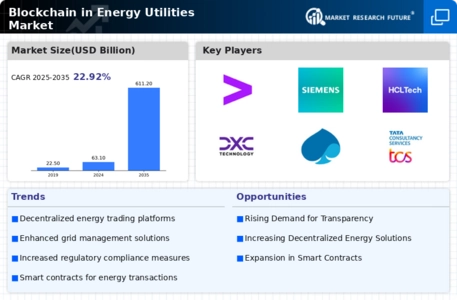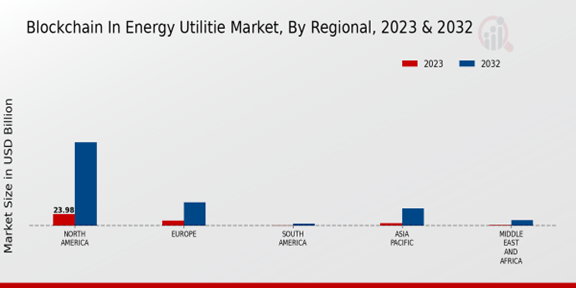Market Growth Projections
The Global Blockchain in Energy Utilities Market Industry is poised for substantial growth, with projections indicating a market size of 63.1 USD Billion in 2024 and an anticipated increase to 611.2 USD Billion by 2035. This growth trajectory suggests a compound annual growth rate (CAGR) of 22.92% from 2025 to 2035. Such figures underscore the increasing recognition of blockchain's potential to revolutionize energy utilities, enhancing efficiency, transparency, and security in energy transactions. The market's expansion is likely to be driven by technological advancements, regulatory support, and evolving consumer preferences, positioning blockchain as a cornerstone of future energy systems.
Enhanced Transparency and Security
Transparency and security are paramount in the Global Blockchain in Energy Utilities Market Industry. Blockchain technology provides an immutable ledger that enhances the traceability of energy transactions, reducing the risk of fraud and ensuring compliance with regulations. This is particularly relevant in markets where energy theft and billing discrepancies are prevalent. By employing blockchain, utilities can offer customers a transparent view of their energy usage and costs, fostering trust and accountability. The increasing regulatory focus on transparency in energy markets further propels the adoption of blockchain solutions, as stakeholders seek to mitigate risks associated with data manipulation and unauthorized access.
Government Initiatives and Support
Government initiatives play a crucial role in the growth of the Global Blockchain in Energy Utilities Market Industry. Various countries are actively promoting the integration of blockchain technology within their energy sectors to enhance efficiency and sustainability. For instance, several governments have launched pilot projects aimed at exploring blockchain applications in energy trading and grid management. These initiatives often come with financial incentives and regulatory frameworks that encourage innovation. As a result, the market is projected to grow significantly, with estimates suggesting a valuation of 611.2 USD Billion by 2035, driven by supportive policies and investments in blockchain infrastructure.
Growing Consumer Awareness and Engagement
Consumer awareness and engagement are pivotal in shaping the Global Blockchain in Energy Utilities Market Industry. As individuals become more informed about energy consumption and sustainability, there is a growing demand for innovative solutions that empower consumers. Blockchain technology enables greater participation in energy markets, allowing consumers to engage in energy trading and management actively. This shift towards consumer-centric models is likely to drive the adoption of blockchain solutions, as consumers seek transparency and control over their energy choices. The increasing focus on sustainability and environmental responsibility further amplifies this trend, suggesting a transformative impact on the energy landscape.
Increased Investment in Smart Grid Technologies
The Global Blockchain in Energy Utilities Market Industry is witnessing increased investment in smart grid technologies, which are essential for the effective integration of blockchain solutions. Smart grids facilitate real-time data exchange and automated control, creating an environment where blockchain can thrive. The convergence of these technologies enhances operational efficiency and reliability in energy distribution. As utilities invest in smart grid infrastructure, the synergy with blockchain technology is likely to yield significant benefits, including reduced operational costs and improved service delivery. This trend aligns with the projected compound annual growth rate of 22.92% for the period from 2025 to 2035, indicating robust market potential.
Rising Demand for Decentralized Energy Solutions
The Global Blockchain in Energy Utilities Market Industry experiences a notable surge in demand for decentralized energy solutions. This shift is largely driven by the increasing adoption of renewable energy sources, which necessitate a more distributed energy generation model. Blockchain technology facilitates peer-to-peer energy trading, enabling consumers to buy and sell excess energy directly. As of 2024, the market is valued at 63.1 USD Billion, reflecting the growing interest in decentralized systems. This trend is expected to continue, as more consumers seek autonomy over their energy consumption and production, thereby enhancing the overall efficiency of energy distribution.
























